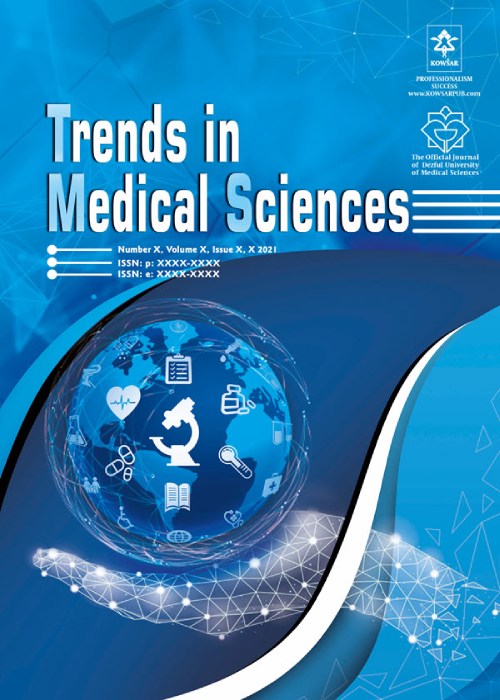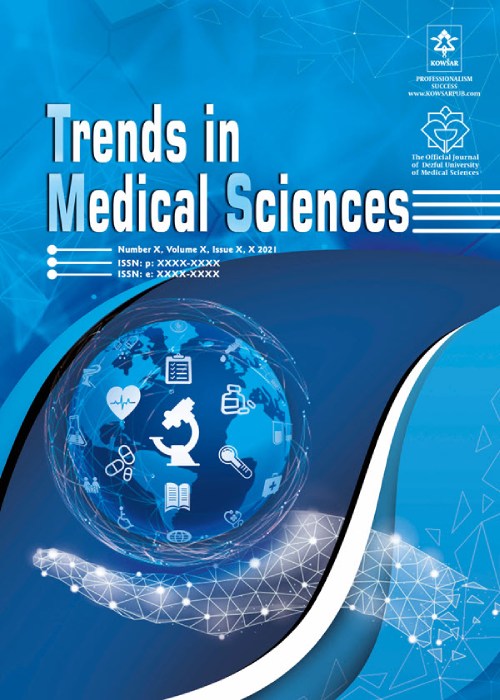فهرست مطالب

Journal of Trends in Medical Sciences
Volume:3 Issue: 1, Winter 2023
- تاریخ انتشار: 1402/09/11
- تعداد عناوین: 8
-
Page 1
Context:
In 2019, a novel Coronavirus officially named byWHOas coronavirus disease of 2019 (COVID-19) pneumonia quickly spread worldwide and became a pandemic. At first, it was considered that the complications just included older populations, but its association with Kawasaki vasculitis disease further complicated the issues.
Evidence Acquisition:
A literature search was conducted using various scientific databases of Springer, Scopus, Wiley, Science Direct, PubMed, ProQuest, Cochrane Library, Embase, and Clinical Key. Keywords COVID-19, Kawasaki vasculitis, Mucocutaneous Lymph Node Syndrome, pediatric, RNA viruses, cytokine storm, 2019 nCoV Diseases, SARS CoV 2 Infection, and SARS CoV 2 were used to filter the search results. After assessing each retrieved article against inclusion-exclusion criteria, 63 papers were deemed eligible for inclusion in this review.
ResultsOur study linked Kawasaki disease with COVID-19 pneumonia in three pathways: (1) interference of angiotensin-converting enzyme 2 (ACE2) receptor and renin-angiotensin-aldosterone system (RAAS) in the pathogenesis of SARS CoV 2 and Kawasaki vasculitis diseases, (2) the similarity of clinical manifestation and immune system response in SARS CoV 2 and Kawasaki vasculitis diseases, (3) the role of COVID-19 as a risk factor next to other risk factors.
ConclusionsKawasaki vasculitis disease could be indicated along with infection with Coronaviridae viruses in pediatrics. Recognition of Kawasaki vasculitis disease with focusing on COVID-19 pathogenesis, aside from restriction of risk factors and detection of best treatment.
Keywords: SARS-CoV-2, Kawasaki Vasculitis, Pediatrics, RNA Viruses, Cytokine Storm -
Page 2Background
Millions of health workers in operating rooms worldwide are exposed to inhaled anesthetics. However, the effects of continuous exposure to inhalational anesthetics are still controversial in many studies.
ObjectivesThe present study investigated the effects of milk thistle, green tea, and cinnamon consumption on liver enzymes in operating room personnel.
MethodsIn this study, we investigated the effects of milk thistle tea, green tea, and cinnamon tea on liver enzymes in operating room staff in a controlled, double-blind study from 2019 to 2020. In two parallel groups, 62 subjects were randomly assigned to ingest the beverages the teas. Milk thistle, green tea, and cinnamon were taken daily for four weeks. During the intervention, all participants were educated about the importance of a balanced diet and physical activity.
ResultsThe milk thistle, green tea, and cinnamon groups showed a significant statistical difference in reduced levels of AST, ALT, ALP, ALB, GGT, bilirubin, and ESR after four weeks (P value < 0.001).
ConclusionsThe results of this study demonstrated that ingesting green tea and cinnamon reduced liver enzymes in surgical personnel. Amongthe extracts, milk thistlehada greater effectonliver enzymesthan the othertwoextracts. It can be concluded that the prescribed milk thistle extract can be considered a potential intervention to improve liver enzyme levels in surgical personnel to reduce the adverse effects of anesthetics.
Keywords: Liver Enzymes, Milk Thistle, Cinnamon, Green Tea -
Page 3Background
Scorpionism is a considerable public health problem worldwide in tropical and subtropical regions. It is one of the major health problems and the leading cause of death in the western and southern parts of Iran.
ObjectivesThis study was performed with the aim of investigating the epidemiological features of scorpion stings in Shoushtar city.
MethodsThis cross-sectional study was performed on 5479 cases in Shoushtar city, Khuzestan province, Iran, from January 1, 2014 until December 31, 2018. First, the incidence rate of scorpion stings was calculated for the study years; then, the bites frequency distribution chart was drawn by month. The t-test and Fisher exact test were used for data analysis using SPSS 22.
ResultsThe average incidence rate of scorpion stinging during the study period was 579.55 per 100000. There was a gradual decrease in the incidence rate over the study period. The incidence of scorpionism was lower in winter, especially in January and February. The most prone body parts of stingwere arms and legs (76%); the stings weremorecommoninmenthanwomenandmore in urban areas than rural areas. Householdwomenhad the highest frequency of stings, so almost 1 of every 3 victims was household women; most stings happened indoors. There was a significant association between gender and location, so it was 13 times more in women than men in an indoor location (P = 0.001, OR = 0.076).
ConclusionsShoushtar is a city with a high incidence rate of scorpion sting in the country, especially in the warm seasons. Most cases of stings occur in Housekeepers and in indoor environments. It seems renovation of residential areas, using chemical controls in roofed areas, and enhancing people’s knowledge regarding the advantage of using gloves and boots can be vital in the reduction of sting incidences.
Keywords: Scorpion Sting, Trend, Mortality, Incidence Rate, Seasonality -
Page 4Background
Spinal anesthesia is one of the most common and safest methods of anesthesia. However, a challenge for patients who are candidates for spinal anesthesia is the pain caused by inserting the spinal needle. It seems possible to reduce needle pain with local pressure, based on the gate control theory in spinal anesthesia.
ObjectivesThis clinical trial aims to evaluate the effect of applying local pressure on the intensity of pain caused by needles during spinal anesthesia.
MethodsIn this study, 120 adult patients aged 18 - 50 who were scheduled for elective surgery under spinal anesthesia and had an American Society of Anesthesiologists (ASA) I-III were randomly assigned to the control and intervention groups. In the intervention group, just before inserting the spinal needle, a local pressure of about 5 kg using the thumb was applied to the skin at the needle insertion point for 15 seconds. The control group received routine anesthesia. The severity of needle pain was compared between the two groups using the verbal rating scale (VRS) tool.
ResultsThe incidence of mild pain in the intervention and control groups was 78.7% and 60%, respectively. Also, the control group experienced higher levels of moderate and severe pain compared to the intervention group. In addition, patients in the control group had a higher chance (odds ratio (OR): 3.4, 95% confidence interval (CI): 1.5 - 7.8, P = 0.039) of experiencing moderate to severe pain compared to the intervention group. Pain intensity was significantly lower in patients with a spinal anesthesia history (P = 0.028).
ConclusionsOur findings showed that applying local pressure on the skin before inserting a spinal needle can effectively reduce pain during spinal anesthesia. However, further studies with a larger sample size are necessary to confirm the effects of applying local pressure to reduce needle pain during spinal anesthesia.
Keywords: Needle, Gate Control Theory, Pressure, Pain Management, Anesthesia, Spinal -
Page 5Background
Prostate prostate cancer (PCa) is a common disease in men, possessing the second-highest incidence rate and the fifth-highest mortality rate worldwide. Diagnosis of PCa depends on factors such as rectal examination, total serum PSA level, and the result of prostate biopsy. Our study aimed to evaluate the results of rectal prostate biopsies taken through the 12-core method under the direction of ultrasound.
ObjectivesTo assess the results of transrectal ultrasound-guided prostate biopsy by the 12-core method.
MethodsThis cross-sectional research was conducted on 60 patients with prostate tumors who had indications for biopsy from 5/2021 to 5/2022 at the Can Tho University of Medicine and Pharmacy Hospital. Our patients were required to score 2 points on the international prostate syndrome score (IPSS) and quality of life (QoL) index. We used descriptive statistics to present the data. Indications for undergoing prostate biopsy were abnormal digital-rectal examination findings and/or an elevated total prostate-specific antigen (PSA) serum level (greater than 10 ng/mL). The participants received prophylactic intravascular bacsulfo (1000 mg) and oral metronidazole (500 mg) before the procedure, which was continued for about 3 days. A Fleet enema was self-administered the night before the procedure for rectal cleansing.
ResultsThe average age of the patients was 68.72 years, and the most common reason for hospitalization was dysuria (80%). The average IPSS score was 26.21 ± 4.49, and the average QoL index was 3.38 ± 0.67. The mean serum total PSA was 26.11 ng/mL. The PCa detection rate after the biopsy was 40% (24/60), and Gleason’s score for 45.83% (11/24) of these patients was 8 or above. There were two cases of strong rectal bleeding (3.33%) and one case of strong hematuria (1.67%).
ConclusionsTransrectal ultrasound-guided prostate biopsy is a valuable and feasible procedure for the diagnosis of PCa at our hospital.
Keywords: Prostate Biopsy, Prostate Cancer, Transrectal Ultrasound -
Page 6Background
This study was conducted to explain the Muslim husband’s attitude toward women undergoing mastectomy.
MethodsIn this content analysis research, 18 participants were selected by purposive sampling, semi-structured interviews were conducted, and the results were analyzed by the Elo and Kyngas method.
ResultsIn this content analysis, the husbands found two approaches to the patient: A positive and a negative approach to the patient. A positive approach included making the patient more beautiful after illness, maintaining the patient’s beauty before and after the disease, and knowing the patient as a hero. A positive approach included loss of beauty after illness, decreased patient attractiveness after illness, disfigurement after treatment, and acceleration of aging in the last days of life.
ConclusionsFrom the present study’s findings, it can be concluded that husbands’ views on women undergoing mastectomy are different and should be considered in psychological interventions between couples.
Keywords: Breast Cancer, Partner, Husband, Attitude -
Page 7Introduction
Although indigenous malaria cases have dramatically declined over the past decades, the COVID pandemic has continued to affect the programs designed to combat malaria, particularly in those countries where hydroxychloroquine and chloroquine have been used as medications for treating COVID. Two immigrants entered Iran illegally from neighboring countries (i.e., Afghanistan and Pakistan). This study mainly aimed to assess the effects of coronavirus disease (COVID-19) on these cases from all aspects (i.e., case-finding, diagnosis, and treatment).
Case PresentationBoth cases presented withcommonsymptoms such as fever and shaking chills. In addition, they had no sign of COVID-19, and their oxygen level and CT images were normal in some cases, but they were mistakenly treated as COVID-19 patients long after the onset of malaria symptoms. One of the suspected coronavirus cases was given chloroquine on a voluntary basis for one day, which may have been responsible for the possible relapse in vivax or resistance of plasmodium vivax to chloroquine and the recurrence of parasitemia in falciparum.
ConclusionsThe active case detection of malaria was affected by the COVID-19 pandemic. Case finding was dramatically decreased with the onset of coronavirus, thereby causing a spurt in malaria incidence. Moreover, the malaria treatment strategywasnegatively affected by the misdiagnosis of COVID-19.
Keywords: Imported Malaria, COVID-19, Chloroquine, Case-Finding, Misdiagnosis


